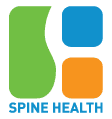It was the early 1990's in the United Kingdom, I had just had my first MRI scan, and as a medical practitioner I was allowed into the radiology office, and on the screen were images of a cervical spine which had considerable problems at several levels. To discover it was mine, gave me surprise and concern.
Yes I had been suffering with neck and arm pain, but apart from that, I felt really fit and well, I was only in my thirties, and had no family history of such severe problems.
Before hospital work and family medicine, I had been an active gymnast, sports player and runner at school, I had been fitter than most during my army officer training and had completed all the physical tasks required of a young regimental medical officer on active service in various parts of the world. There had been a few times when my back had suffered, especially when jumping daily with a large medical pack from helicopters in Northern Ireland, but as the only doctor in the area, I carried on and soon recovered.
Later as a family doctor and first aid brigade surgeon, I also covered many sporting events for medical support, and after lifting casualties had once needed a spell on hospital traction for my lumbar spine, but had recovered well and was still fit, golfing regularly, playing squash, football and skiing with my four children each winter.
I enjoyed my job immensely, got further qualified in occupational health (O.H.), founded a national O.H. medical company and studied for my MBA, all of which meant very hard physical and mental work, with many hours every day examining, reading, writing and especially much computer time.However, now amazed to see several discs pushing into my spinal cord at several levels in my neck, I went to see a local neurosurgeon in the UK, who looked at the images and said 'he last time I saw a neck like this was in a parachutist' (even before he knew my history).
Not particularly concerned with the cause, I wanted to know what could be done. He said open surgery from the front of the neck, displacing the windpipe, gullet, thyroid, major blood vessel and nerves, to then remove the prolapsed discs, replacing them with bone from my pelvis. He explained that the risks involved significant minor and major side effects including the possibility of being quadriplegic (i.e. paralysed from the neck down!).
My medical approach to my own patients had always been conservative, to avoid risky treatments where possible, and I was not going to be any more cavalier with myself. The neurosurgeon somewhat reluctantly agreed to try to avoid surgery but insisted I must reduce my pace of work. This was not easy, but I resolved to slow down and to try to get away on holiday to the sunshine as often as possible, and with this the condition did settle down at times.
However in 2004, the neck pain became intractable, and I began to loose the use of my dominant left arm. I had now to seek surgery, and looked at Minimally Invasive Spinal Surgery (MISS) in the UK. A specialist in Manchester said the UK had some experience in MISS for the lumbar spine, but there was little experience of the cervical spine, and mentioned a centre of excellence in South Korea lead by Professor (Dr) Sang Ho Lee.
My research included respected journals, Medline, and Internet sources of which many lead to the Wooridul Spine Centre in Seoul, and so I contacted Dr Lee's team, who were extremely helpful.
After the long journey to Korea, hoping to have the MISS, I was met personally at the Incheon airport by Mr. James Lee, the senior administrator for overseas patients, and was soon undergoing detailed investigations with the most advanced imaging technology I had ever seen. Professor Lee saw me straight after and gave me some bad and good news.
He said that my extensive disc problems and spinal stenosis were too advanced for MISS, and advised open surgery with the reassurance of much lower side effects than previously suggested. I accepted and next day had open surgery, discectomies at C4/5/6 levels, with insertion of allografts from cadaver bone, with titanium steel plate and screw fixation to aid the fusion of the central part of my neck.
I expected a lot of pain, but the control was excellent, with absolutely no complications, the nursing care was great, the conditions were comfortable and the food was good. When the dressings came off, the scar was small, clean and already hardly visible. I was elated, (not only from the necessary steroids) but also at the already good results, arm pain much less, usage returning, and less numbness.?
Professor Lee explained that all had gone well, with good stabilisation at the treated levels. However the fusion of the central part of the neck could mean the rest of my spine would have to take more of the strain. Physiotherapy was provided, with exercises and postural advice to continue.
After returning to the UK in a neck collar, I was indeed much improved, and with modifications to my work place, I was able to get back part time work. When examining patients, reading, writing or working on computers, I tried to flex at the thoracic and lower levels to reduce the neck flexion.
I visited Korea in 2005 and 2006 and although there were still some problems of stenosis and disc narrowing at other cervical levels, I was delighted to see that the treated levels were fused, stable and that the cervical spine surgery had been very successful.
I was able to continue working part time with the rest, long winter holidays, and work adjustments until 2007, when a new problem emerged. - I started with chest pains.
Having excluded cardiovascular disease, the pain appeared be referred from my thoracic spine. This time I went promptly to Prof Lee in Korea. Very extensive investigations confirmed prolapsed discs, now in the thoracic spine also confirmed by provocation discography under CT vision.
This time, (probably because I did not delay), I was able to be treated by MISS, and underwent discectomies in March/April 2007 at the T8/9 and T4/5 levels. This was done under local anesthetic with a team of very experienced radiologists and neurosurgeons removing the majority of the disc material using their advanced imaging techniques, treatment of remaining disc space by Holmium Yag laser, and with some widening of some of the bony spaces which were also trapping nerves.
The alternative could have been as extensive as having to open my chest cavity, bypass the heart, and collapse the lungs, to remove the thoracic discs directly, with potentially very serious side effects.
At W.S.H. I was able to leave hospital in a chest brace the next day, and after staying in Asia for a month after the last procedure, I returned to the UK in May 2007.
I accept that the condition of my spine will always cause some pain and restricted movement, however currently the chest pain has almost completely gone and I have use and feeling in both my arms. Although I have been told to take it very easy for the future, I still hope to be able to return to some work even if only for a few hours per week.
The recent investigations also suggest that T2/3 level is also a potential problem, but most of my spine is now much more stable, and with the reduction in pain, I am very pleased with the success of my treatment by the Wooridul Spine Hospital team.
I hope that now by accepting their advice, I can avoid further surgery, but should other parts of my poor spine start to flare up I will have no hesitation in returning to WSH, and would recommend their expertise, and care to anyone with spinal problems.
Dr Robert A Wells. M.B. Ch.B. B.Sc. (Hons). M.R.C.G.P. M.B.A. Pt I+II. D.Occ.Med.
Please Click Here to request more information from Wooridul Spine Hospital.


.png)



